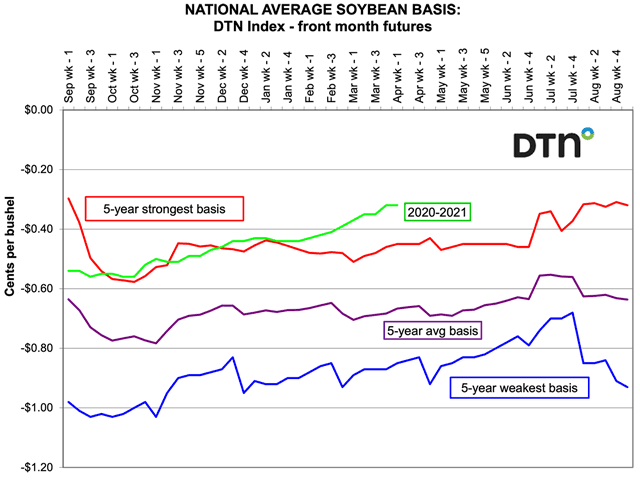Cash Market Moves
Soybean Basis Up, Up and Away
The DTN national average basis started the new-crop year of 2020-21 running close to the five-year strongest basis and has been climbing ever since. As you can see in the chart at the start of January 2021, the basis reached the DTN strongest five-year basis and by the end of that month had moved above it and hasn't looked back.
Country elevator posted bids in some parts of the Upper Midwest are nearly double what they normally are this time of year with a few areas showing a positive basis where "normal" basis is usually negative. But this isn't a normal year for soybeans, and the March 31 USDA report gave a hint as to why.
USDA noted in their March 31 Grain Stocks report that soybeans stored in all positions on March 1 totaled 1.56 billion bushels (bb), down 31% from March 1 the previous year. Soybean stocks stored on farms are estimated at 594 million bushels (mb), down 41% from a year ago. Off-farm stocks, at 970 mb, are down 22% from last March. Hence, dwindling supplies.
Dana Mantini, DTN senior analyst, in his review of the March 31 USDA reports, said, "Soybean planting intentions were revealed at just 87.6 million acres, some 2.4 million acres below the average pre-report estimate. While still up 5% from a year ago, the estimate was shy of the nearly 90 million acres estimate from Dow Jones. That shocking acreage number -- coupled with the expected but 31% lower inventory number of 1.56 billion bushels -- implied that U.S. soybean ending stocks were on a course for an even tighter carryout than our meager 120 million bushels this year. December through February soybean disappearance was 1.38 billion bushels, up 39% versus a year ago."
P[L1] D[0x0] M[300x250] OOP[F] ADUNIT[] T[]
Read Mantini's review here: https://www.dtnpf.com/…
One can beg the question: Is it supply or demand that is controlling soybean prices? The answer would be both, but in the end, supply, or lack thereof, is the culprit. The U.S. saw China buy up soybeans at a quick pace early in the crop year but has since slowed purchases. Japan and Mexico have also been buyers of U.S. soybeans, but China is responsible for at least 65% of U.S. exports. Even still, export basis at the Pacific Northwest has been absent in the nearby months for quite some time and the soonest basis bid published there is for September 2021.
Demand is also strong for soybean byproducts meal and oil. Processed soybeans are the world's largest source of animal protein feed and the second largest source of vegetable oil. The U.S. is the world's leading soybean producer and the second-leading exporter. Soybeans comprise about 90% of U.S. oilseed production, while other oilseeds, including peanuts, sunflower seed, canola and flax, make up the remainder, according to the USDA Economic Research Service (ERS).
Domestic demand for U.S. soybean meal and oil is rising rapidly on thriving meat exports and stable crude oil usage, notes USDA. Soybean oil demand as a feedstock has also seen a pick-up due to rising biodiesel purchases.
According to the March 11 USDA ERS Oil Crops Outlook, January crush volumes were the second highest on record at nearly 197 mb, up 4% year over year. Through the first five months of the marketing year, 2020-21 crush volumes total 949 mb, a nearly 6% increase over the same period last year. The increase in crush demand derives from strong margins for soybean meal and soybean oil. https://usda.library.cornell.edu/…
Will the U.S. "run out" of soybeans for domestic usage? USDA said, "Due to the limited supply of soybeans, the ability of the domestic crush sector to continue at its record pace is limited."
There is always the likelihood soybeans will have to be imported into the U.S., and rumors of soybean oil imports have been swirling with no confirmation yet. Regardless of what happens, you can expect that soybean basis has nowhere to go but up.
Mary Kennedy can be reached at mary.kennedy@dtn.com
Follow her on Twitter @MaryCKenn
(c) Copyright 2021 DTN, LLC. All rights reserved.




